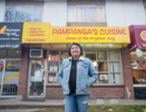(Editor’s note: Boothroyd is guest blogging about last week’s urban health conference in Vancouver. This is his second dispatch.)
Public health is often an authoritarian business. Epidemiologists study “vulnerable” populations, Surgeons General issue directives, the World Health Organization quarantines whole cities.
This is just part of the picture, of course, and many of public health experts are today singing the virtues of inclusive approaches to “health for all.”
In Vancouver investigators in the recent North American Opiate Medication Initiative (NAOMI study) engaged drug users in planning many aspects of this important clinical trial of prescribed heroin. And plugging in – or at least acknowledging – people power was an abiding theme at last week’s excellent 7th International Conference on Urban Health. (For abstracts of talks mentioned below, go here.)
Donna Hill of Richmond, B.C., gave a poster presentation titled “Stories of resiliency rather than 'illness': Urban aboriginal women living with HIV.”
Parul Rishi of the Indian Institute of Forest Management presented the findings of a survey of 224 residents of the city of Bhopal. This suggests that folks there have a robust sense of well-being, thanks to time with family and friends, often in lakeside parks and forests and other coping mechanisms. This, despite such stresses as over-stimulation from mobile phones, rising noise pollution, exploding slums and – as Rishi mentioned in a footnote – the aftermath of Union Carbide’s 1984 explosion, which gassed half a million residents, killing 8,000.
Dr. Roderick Lawrence of the University of Geneva, meanwhile, gave a keynote speech about something called transdisciplinarity. This is research that captures non-scientific (or “tacit”) knowledge by including in research teams representatives of groups being studied, as well as experts across a range of academic disciplines and from public authorities and the private sector.
An example would be PlanetNYC, a Columbia University project, which aims to engage college and high-school students as well as local citizens in planning for the urban impacts of climate change. For example, as oceans rise and warm up, flooding from storm surges threatens hundreds of thousands of New Yorkers in low-lying communities.
Speaking at the conference, Professor Ernest Drucker said that New York authorities have redoubled their efforts to plan for flooding, since at least Hurricane Katrina. But the plans have been developed in a generic, top-down manner and few New Yorkers know about them. Drucker, editor of Harm Reduction Journal and a distinguished researcher, hopes to address this weakness by engaging residents of exposed communities in research and planning.
In a first initiative, he established a multidisciplinary team of Columbia faculty and students, backed by planning authorities and representatives of Brooklyn’s UPROSE (the United Puerto Rican Organization), an environmental justice organization.
Beginning in the waterside Brooklyn community of Sunset Park, pop. 150 000, the researchers marshalled geographic, meteorologic and urban planning data to develop detailed maps pin-pointing a water works, a hospital and a prison, as well as industrial and residential zones, the number of basements (at risk of flooding), etc. They then developed a template plan, which they put before high-school students in an UPROSE program and other local residents.
The questions often surprised them. Students: “Many low-income communities cannot get up and leave to stay with friends or relatives (who might also be affected, and not have enough space). Where do they go?”. Among the student recommendations: “Shock communities into action to address long-term climate change issues (by describing the probability of a hurricane in the next five years).
PlanetNYC has now applied for a grant from NASA’s climate-change program to engage college and high-school students in water-testing, (data needed for assessing the environmental impact of floods), and, as part of a related proposal, measuring ambient temperatures in inner-city streets as part of planning for climate-change-related to heat waves.
“Eventually we want to have a map of all New York neighbourhoods, drawing on detailed local information,” Drucker told me afterwards. “We want to connect different levels of activity: from researchers at the top of the food chain, down to community representatives and college and high-school students who are interested in climate change.
“This way, we’ll train the people who are going to save the world.”
Jim Boothroyd was spokesperson for the NAOMI project conducting prescribed heroin trials in Vancouver, and researches and writes for the World Health Organization and others. The views expressed here are his own.










What have we missed? What do you think? We want to know. Comment below. Keep in mind:
Do:
Do not: